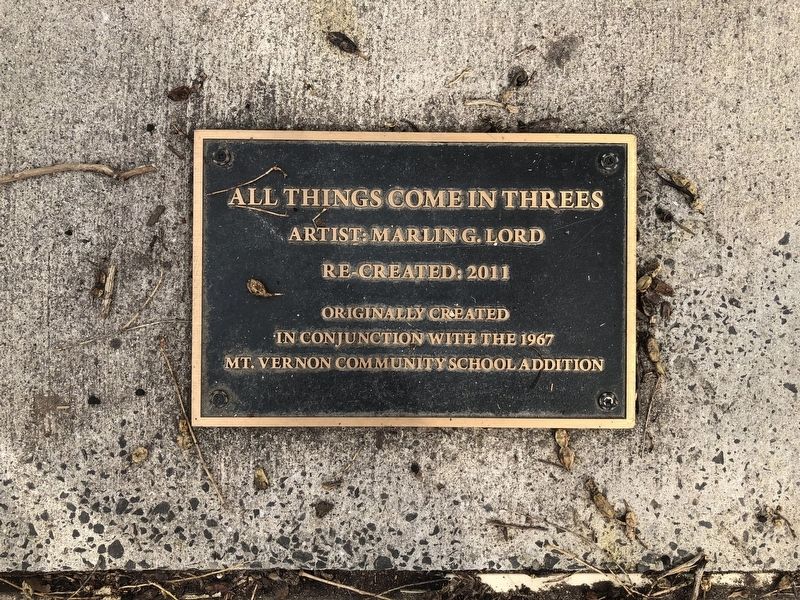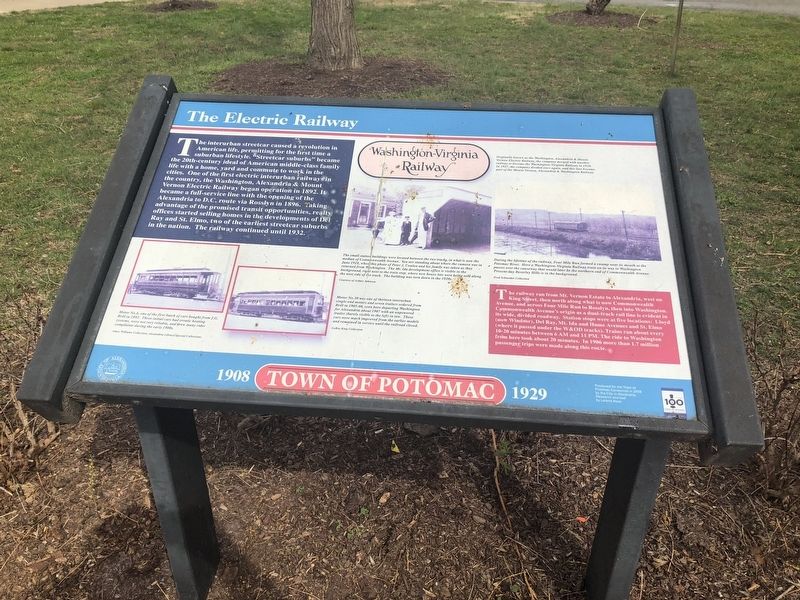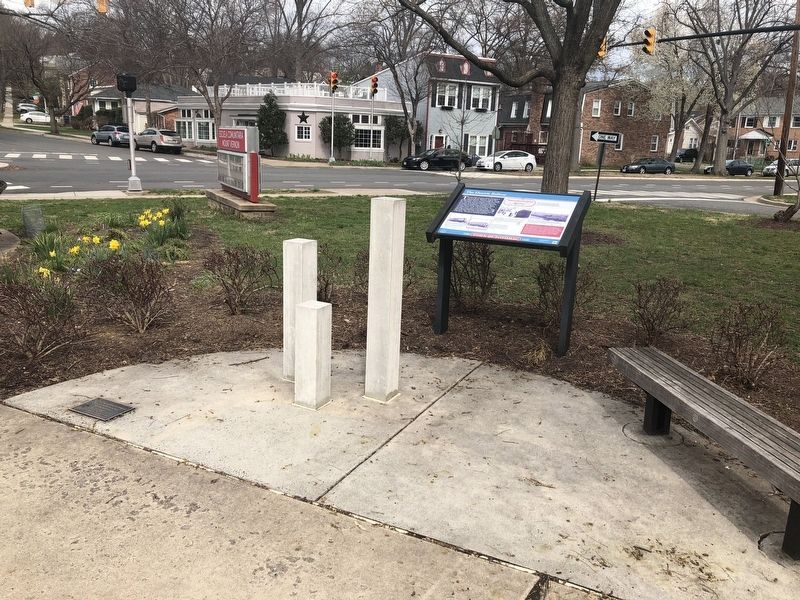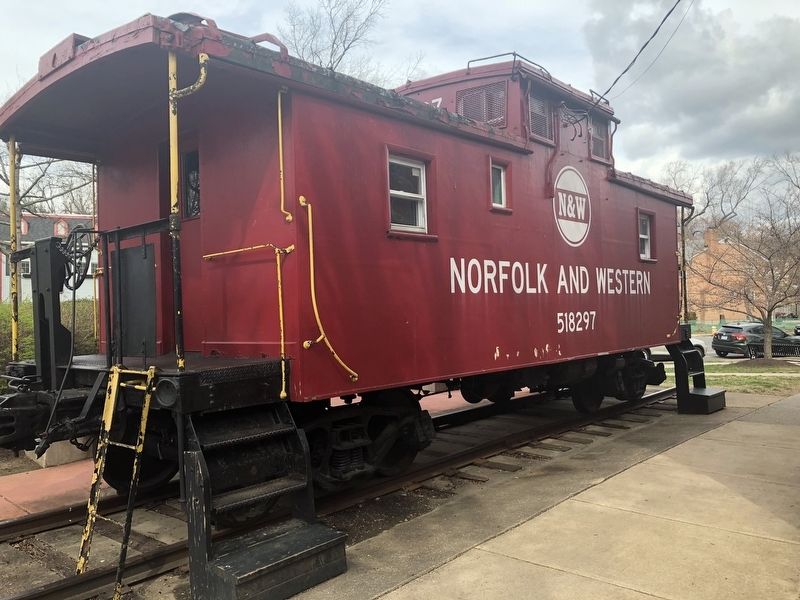Potomac West in Alexandria, Virginia — The American South (Mid-Atlantic)
The Electric Railway
Town of Potomac
— 1908 - 1929 —
The interurban streetcar caused a revolution in American life, permitting for the first time a suburban lifestyle. "Streetcar suburbs" became the 20th-century ideal of American middle-class family life with a home, yard and commute to work in the cities. One of the first electric interurban railways in the country, the Washington, Alexandria & Mount Vernon Electric Railway began operation in 1892. It became a full-service line with the opening of the Alexandria to D.C. route via Rosslyn in 1896. Taking advantage of the promised transit opportunities, realty offices started selling homes in the developments of Del Ray and St. Elmo, two of the earliest streetcar suburbs in the nation. The railway continued until 1932.
The railway ran from Mt. Vernon Estate to Alexandria, west on King Street, then north along what is now Commonwealth Avenue, and across Four Mile Run to Rosslyn, then into Washington. Commonwealth Avenue's origin as a dual track rail line is evident in its wide, divided roadway. Station stops were at five locations: Lloyd (now Windsor), Del Ray, Mt. Ida and Hume Avenues and St. Elmo (where it passed under the W&OD tracks). Trains ran about every 10-20 minutes between 6 AM and 11 PM. The ride to Washington from here took about 20 minutes. In 1906 more than 1.7 million passenger trips were made along this route.
[Captions:]
Motor No. 6, one of the first batch of cars bought from J.G. Brill in 1892. These initial cars had erratic heating systems, were not very reliable, and drew many rider complaints during the early 1900s.
Ames Williams, Collection, Alexandria Library/Special Collections
Motor No. 30 was one of thirteen interurban single-end motors and seven trailers ordered from Brill in 1905-06, seen here departing Washington from Alexandria about 1907 with an unpowered trailer (barely visible to the left) in tow. These cars were much improved from the earlier models and remained in service until the railroad closed.
LeRoy King Collection
Originally known as the Washington, Alexandria & Mount Vernon Electric Railway, the company merged with another railway to become the Washington-Virginia Railway in 1910. In 1927, the company divided once again, and this line became part of the Mount Vernon, Alexandria & Washington Railway.
The small station buildings were located between the two tracks, in what is now the median of Commonwealth Avenue. You are standing about where the camera was in June 1918, when this photo of Peter J. Conlon and his family was taken as they returned from Washington. The Mt. Ida development office is visible in the background, right next to the train stop, where new house lots were being sold
Courtesy of Arthur Johnson
During the lifetime of the railway, Four Mile Run formed a swamp near its mouth at the Potomac River. Here a Washington-Virginia Railway train on its way to Washington passes over the causeway that would later be the northern end of Commonwealth Avenue. Present-day Beverly Hills is in the background.
Fred Schneider Collection
Produced for the Town of Potomac Centennial in 2008 by the City of Alexandria. Research and text by Leland Ness
Erected 2008 by City of Alexandria.
Topics and series. This historical marker is listed in these topic lists: Railroads & Streetcars • Roads & Vehicles. In addition, it is included in the Virginia, The City of Alexandria series list.
Location. 38° 49.691′ N, 77° 3.629′ W. Marker is in Alexandria, Virginia. It is in Potomac West. Marker is at the intersection of Clyde Avenue and Commonwealth Avenue, on the left when traveling north on Clyde Avenue. Touch for map. Marker is at or near this postal address: 2501 Commonwealth Ave, Alexandria VA 22301, United States of America. Touch for directions.
Other nearby markers. At least 8 other markers are within walking distance of this marker. Captain Rocky Versace Plaza and Vietnam Veterans Memorial (within shouting

Photographed By Devry Becker Jones (CC0), March 30, 2018
4. Plaque for artwork immediately in front of the marker
Artist: Marlin G. Lord
Re-Created: 2011
Originally Created
In conjunction with the 1967
Mt. Vernon Community School Addition
Credits. This page was last revised on January 27, 2023. It was originally submitted on March 31, 2018, by Devry Becker Jones of Washington, District of Columbia. This page has been viewed 279 times since then and 16 times this year. Photos: 1, 2, 3, 4. submitted on March 31, 2018, by Devry Becker Jones of Washington, District of Columbia. • Bernard Fisher was the editor who published this page.


